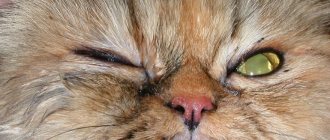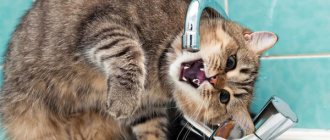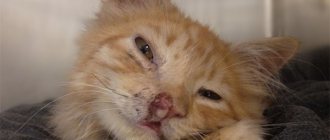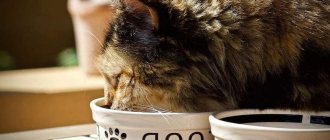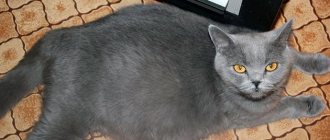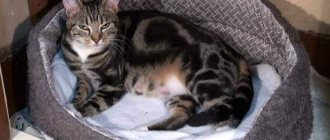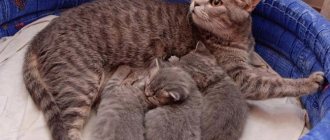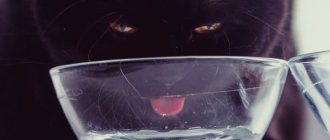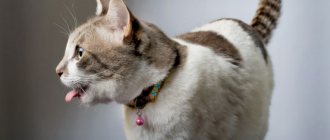Cat owners often have questions about how long their pet can last without water. Knowledge will help you determine the correct departure time, as well as the need to call relatives to feed and clean up after your pet.
Giving your cat up for foster care is a bad idea, as cats start to get very sick afterwards. To give an accurate answer to the question: “How long can a cat live without water?”, it is worth considering it from a scientific perspective.
The importance of water for the cat's body
Liquid plays a big role in the life of an animal. The body consists of 70% water, but despite this, it must be regularly supplied to the body.
Thus, it performs a number of functions:
- Oxygen and nutrients are transported from cells to the blood.
- Involved in regulating body temperature.
- Protects and protects internal organs.
- Removes metabolic waste.
- Facilitates food absorption and digestion.
- Removes toxins and impurities.
In addition, very often a lack of water in the body causes urolithiasis. It is especially common among neutered cats.
Consequences of prolonged fasting
Prolonged fasting does not have the best effect on the general condition of the animal. The body is forced to use reserves of previously deposited fat, as well as glycogen accumulated in the muscles and liver. If forced fasting continues for a long time, the body receives energy from muscle protein, which has an extremely negative effect on metabolism. A dangerous disease develops - nutritional dystrophy.
If the animal has clearly been starving for a long time, it is unacceptable to feed it immediately. It is better to give a small amount of water. Food is offered fractionally, in tiny portions, the number of meals is up to 7 per day. This will help to gradually improve the functioning of the digestive system without subjecting it to severe stress. If you overfeed a hungry cat, there is a high risk of death.
How long can a cat live without water?
There are several factors that affect how long pets can live without fluid:
- Season. Due to the heat, cats need more water in summer than at other times of the year. Therefore, it is much easier to get dehydrated in the summer.
- Age is another very important factor. Kittens will not last long, no more than one day, than adult cats.
- Nutrition. When feeding dry food, more water is required, and its shortage is more acute.
- Breed. There are breeds where the animal hardly drinks water, because it doesn’t really need it, for example the British.
- Activity. Active animals require more fluid than inactive animals.
On average, a cat can live no more than 5 days without water; after two days, serious consequences are possible. If she is sick, the time is reduced to several hours.
Reasons for refusing food
A decrease in the appetite of an adult cat or kitten is a cause for concern for any owner. There may be several reasons, some, for example, stress due to a change of residence or extreme heat, due to which a healthy cat refuses food, are considered quite natural and gradually disappear. Others are the first signs that you need to urgently show your pet to a veterinarian.
Main reasons:
- Poor quality or tasteless food. Cats are gourmets; they often don’t like the medicinal food recommended by a specialist, so they refuse to eat it as a sign of protest. You'll have to choose another brand.
- Diseases. Problems with the gastrointestinal tract, liver, and cancer cause the animal to lose its appetite and overall interest in life.
- Sometimes a pet tries to attract the attention of its owner by hunger.
- Sexual heat of a cat or estrus in cats.
It is necessary to carefully monitor your pet’s behavior; if he does not eat or drink for more than two days, immediately contact a veterinary clinic.
Required amount
On average, 50 ml per 1 kg of weight, but it also depends on the above factors.
What kind of water is considered healthy?
The quality of water also affects the health and life expectancy of a cat. The best option is soft and purified water at room temperature.
It is recommended to give it filtered or frozen.
It is better not to give them tap water, as it may contain a large number of different impurities. Cats especially should not drink from the aquarium and toilet.
Pour the liquid into a special container, wash and change the water daily. In addition, you can add various supplements, such as tuna juice (the smell will attract), iodine, fluoride, nutritional drinks for cats.
Why doesn't the cat drink?
It is much worse when the cat simply does not drink water.
There may be several reasons for this:
- She already receives the required amount of water. Meat and wet food already contain a lot of liquid.
- An animal may refuse to drink water if it is of poor quality. Try changing something: temperature, filtering, refreezing. Or change the bowl, wash it more thoroughly, change the place for drinking, perhaps the cat just doesn’t like it.
- Disease. In such cases, he refuses not only water, but also food. You need to see a veterinarian.
- Stress. During this period, the cat may not drink for several days.
- Climate change. The acclimatization period has a detrimental effect not only on humans, but also on animals. During this period, the cat will feel unwell and may refuse food and water.
Slime coat
Other creatures suffering from drought have found a way to protect their bodies so as not to lose water from them. The deserts of North America are home to spadefoot toads, which use their claws to dig deep burrows underground. There they hide for three quarters of the year. While in these burrows, toads produce a mucous membrane to conserve water. They appear on the surface 10 months later, when they feel the strong sound of rain on the surface.
Some tree frogs also reduce water loss by secreting an impenetrable waxy material on their skin. In South and Central America, tree wax frogs look for a safe place and then begin to press on the throat and abdominal walls. At the same time, with the help of their paws, they rub lipid secretions throughout the body.
Or he drinks too much
If your cat drinks excessive amounts of liquid, this may indicate a disease. Such as diabetes, kidney failure, infection, fever.
- But there are other reasons: heat, dry food, high activity, pregnancy. And also age.
- Older individuals need more fluid. In such situations, a completely healthy animal can drink a lot of water.
- If none of the points match, you should contact your veterinarian.
Signs that your pet is completely healthy: shiny coat, elastic skin, normal physical activity.
Cat without food
Food is a cat’s second need after water. Unlike the first need, a pet can survive without a second need for about a week, kittens for about 17 hours. They are used to eating a lot, but in small portions.
When there is a lack of food in the body, their organs suffer, primarily the kidneys and liver, which can also lead to various diseases.
- Causes: Stress, acclimatization, too frequent changes in diet, poisoning, surgery, hormonal changes, illness, tick bite.
- Consequences: Weight loss, loss of strength, constipation, kidney failure, hair loss.
Feeding your cat from your table is strictly prohibited! Various severe pathologies may develop.
When to go to the vet
- Dry and warm nose. In a healthy animal it is cold and damp.
- Body temperature is above 37-38. It is a sign of infection in the body.
- Diarrhea and vomiting, like fever, are a symptom of infection.
- Deterioration of condition.
How to breathe
Moreover, camels, ostriches and marsupial rats have specialized respiratory systems that help them exhale less air.
The air in the lungs of marsupial rats is always warm and saturated with water, but the tips of their noses are cold. In the middle there is a long and winding passage for air. As air passes from the lungs into the atmosphere, the water vapor cools and condenses on the lining of the nose. After condensation, the water is returned back rather than wasted into the atmosphere.
When the rat gets into its hole, it exhales this water vapor and it becomes trapped there. Then the rat breathes it again.
Dehydration
A disease that occurs due to the loss of large amounts of water.
Symptoms:
- Arrhythmia
- Dry skin
- Decreased appetite
- Viscous saliva
- Lethargy and lack of activity
- Constipation or diarrhea
- The animal begins to hide in corners
- Increase and decrease in temperature
Treatment: When you notice the first signs of dehydration in your cat, you need to try giving him fluids yourself.
If the animal is vomiting, you can inject 10 ml of sodium chloride solution, this will help significantly improve its condition. But the most necessary thing is to go to a veterinary clinic.
Prevention:
- Monitor your cat's availability of water.
- In addition to dry food, also provide wet food.
- Do not allow the animal to overheat in the sun.
Cats need water just like people. When you get a pet, you must treat it with full responsibility, because its life and health depend only on you.
Possible duration of the hunger strike
In the absence of food, the body begins to obtain energy by breaking down adipose tissue; weight loss during a diet is based on this; in animals everything happens similarly. The cat is losing muscle mass. The appearance deteriorates, the fur begins to fall out, becomes dull, and loses its shine. If you don't eat for a long time, inevitable death will occur.
An adult healthy cat can live without food for about a week. For small kittens the period is shorter - no more than a day. If a pet is sick, its body can survive for about 4 days. A pregnant cat can withstand the same amount of time.
Of course, there were cases when animals remained alive after a 30-day hunger strike. But such situations are rare and not every owner will subject their pet to such a test. In many ways, the length of time that an animal can endure depends on its internal reserve, endurance and state of health.
